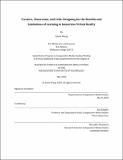Creators, classrooms, and cells : designing for the benefits and limitations of learning in immersive virtual reality
Author(s)
Wang, Annie
Download1192966594-MIT.pdf (2.410Mb)
Other Contributors
Massachusetts Institute of Technology. Department of Comparative Media Studies.
Advisor
Eric Klopfer.
Terms of use
Metadata
Show full item recordAbstract
In the last few years, the perception of virtual reality (VR) has shifted from an entertaining novelty to an increasingly mainstream technological medium. However, the methods of creating and assessing high-fidelity immersive VR for learning remain nascent. With the growing demands for change in the 21st-century American education system, it is increasingly important for designers and developers to approach the topic of VR for K-12 learning thoughtfully yet critically. This thesis grounds VR within the greater context of technology-mediated learning by examining its affordances, relevant educational frameworks, and cognitive limitations through the academic lenses of pedagogy, cognitive science, and educational psychology. It then utilizes a case study, the CLEVR project, to trace an in-depth example of an ongoing VR game through user feedback, data analysis, and iterative game design. Ultimately, I use findings generated from the CLEVR project to develop recommendations for designing and integrating VR into K-12 classrooms, with the hopes of informing current and future designers about balancing VR's affordances with learning outcomes in order to develop successful immersive learning experiences.
Description
Thesis: S.M. in Comparative Media Studies, Massachusetts Institute of Technology, Department of Comparative Media Studies/Writing, May, 2020 Cataloged from the official PDF of thesis. Includes bibliographical references (pages 91-100).
Date issued
2020Department
Massachusetts Institute of Technology. Program in Comparative Media Studies/WritingPublisher
Massachusetts Institute of Technology
Keywords
Comparative Media Studies.